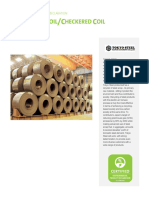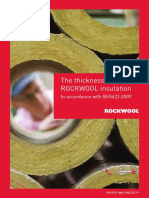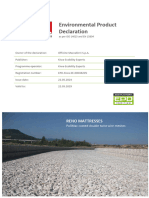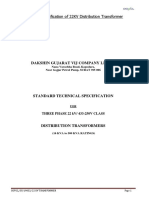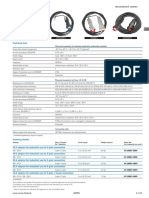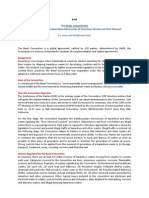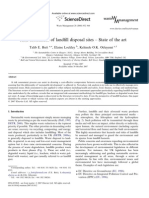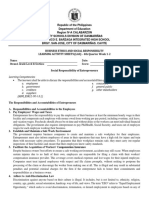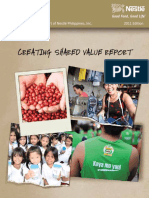Environmental Product Declaration: Arcelormittal
Environmental Product Declaration: Arcelormittal
Uploaded by
Abhiram shuklaOriginal Title
Copyright
Available Formats
Share this document
Did you find this document useful?
Is this content inappropriate?
Report this DocumentCopyright:
Available Formats
Environmental Product Declaration: Arcelormittal
Environmental Product Declaration: Arcelormittal
Uploaded by
Abhiram shuklaCopyright:
Available Formats
ENVIRONMENTAL PRODUCT DECLARATION
as per ISO 14025 and EN 15804
Owner of the Declaration ArcelorMittal Europe-Long Products
Programme holder Institut Bauen und Umwelt e.V. (IBU)
Publisher Institut Bauen und Umwelt e.V. (IBU)
Declaration number EPD-ARM-20160051-IBD3-EN
ECO EPD Ref. No. ECO-00000442
Issue date 20/09/2016
Valid to 19/09/2021
Reinforcing steel in bars
ArcelorMittal
www.ibu-epd.com / https://epd-online.com
Umwelt Produktdeklaration Name des Herstellers – Name des Produkts
1. General Information
ArcelorMittal Reinforcing steel in bars
Programme holder Owner of the Declaration
IBU - Institut Bauen und Umwelt e.V. ArcelorMittal Europe-Long Products
Panoramastr. 1 66, rue de Luxembourg
10178 Berlin L-4221 Esch-sur-Alzette
Germany Luxembourg
Declaration number Declared product / Declared unit
EPD-ARM-20160051-IBD3-EN 1 metric ton of reinforcing steel in bars
This Declaration is based on the Product Scope:
Category Rules: The declaration applies to 1 metric ton of reinforcing
Reinforcing Steel, 07.2014 bar produced by ArcelorMittal
(PCR tested and approved by the SVR) The Life Cycle Assessment is based on data collected
from the four ArcelorMittal plants producing rebar
Issue date (Ostrava in Czech Republic, Jorf Lasfar in Morocco,
20/09/2016 Warsaw in Poland, Zenica in Bosnia and Herzegovina).
It covers 100% of the annual production from 2015.The
owner of the declaration shall be liable for the
Valid to underlying information and evidence; the IBU shall not
19/09/2021 be liable with respect to manufacturer information, life
cycle assessment data and evidences.
Verification
The CEN Norm /EN 15804/ serves as the core PCR
Independent verification of the declaration
according to /ISO 14025/
Prof. Dr.-Ing. Horst J. Bossenmayer internally x externally
(President of Institut Bauen und Umwelt e.V.)
Dr. Burkhart Lehmann Dr. Frank Werner
(Managing Director IBU) (Independent verifier appointed by SVR)
2. Product
2.1 Product description / Product definition 305/2011/ applies.
Rebar (Reinforcing Steel in bars, including standard As no harmonized product standard exists, no
rebars, special rebars – Krybar®, rock bolt and tie bars Declaration of Performance and following to that no
- and threaded bars) covers carbon steel for CE-marking may be required.
geotechnical use and the reinforcement of concrete
according to EN10080 standard. The surface of rebars For the application and use of the products the
is patterned to form a better bond with soil and following standards apply: /EN 1992-1-1/, /EN 1992-1-
concrete; in addition the ribs on threaded bars, rock 2/, /EN 1992-2/, /EN 1992-3/.
bolts and tie bars allow for bolting. EN10080 is not yet
a harmonized standard and has to be considered as 2.2 Application
an open standard, i.e. with no steel grades. Therefore, Reinforcement bars are steel rods that are used as a
steel grade might be specified in some national tension device in concrete. Typical applications are in
standards or labels as for instance mentioned in the the construction of buildings, bridges, roads and other
following table. civil works (infrastructures, superstructures, etc.) as
well as mining.
2.3 Technical Data
Delivered product may contain many types of alloys,
depending on the intended performance and
characteristic of the steel product.
Constructional data
Name Value Unit
Tensile strength 483 - 1100 N/mm2
Type of steel (Bar, coil, welded Bar and
-
fabric, lattice grinders) coils
For the placing on the market in the EU/EFTA (with EAF and
Production route (EAF or BF) -
the exception of Switzerland), /Regulation (EU) No. BOF
2 Environmental Product Declaration ArcelorMittal – Rebar
Weldability <0,79 Ceq basic oxygen furnace (or in a tandem
Yield strength 460 - 900 N/mm2 furnace), blowing oxygen to lower carbon
Surface geometry (fR or PRA) - - content in the steel and obtaining liquid steel
Elongation (Agt) 2,5° - 7,5° % with the required characteristics.
Recycled content 69 %
Fatigue Test Requirements -
Stress level and cycle number - - Electric arc furnace (EAF) route: Different
depend on local regulation steel scraps are melted in an electric arc
Density 7850 kg/m³ furnace to obtain liquid steel. This steel is
Modulus of elasticity 210000 N/mm² then refined in a ladle furnace with addition of
Coefficient of thermal expansion 12 10^-6K^-1 ferroalloys and metals to obtain the required
Thermal conductivity at 20°C λ 48 W/(mK) steel characteristics.
Melting point depending on the
1536 °C
alloy proportions up to
Bend and Re-bend test According The steel is then cast at a continuous caster to obtain
min. 90 ° semi-finished products as billet or blooms. The semis
to EN ISO 15630-1
are then rolled to the desired size. The rib profile is
rolled onto the bar in the last stand of the rolling
Product standards: /EN 10080/ completed by national process. They are two methods to achieve the required
standards and/or national certifications such as, e.g. mechanical properties in hot rolled bars, either through
National Certifications are provided by notified in-line heat treatment QST (Quenching and Self-
bodies such as /Dibt/ (G), /Ocab/ (B), /Afcab/ (F), Tempering) or by micro-alloying additions. At the end
/Kiwa/ (NL), /Empa/ (Ch), /Aenor/ (SP), /ZETOM/ and of the rolling operation, the rebar is cut to the required
/SIMPTEST/ (Poland), /SNIMA/ (Morocco), /GlobeCert length, generally bundled and labeled.
AB/ (Scandinavian market). for UK, /BS4449/ and
/CARES/, for Germany B500B according to /DIN 488/. 2.7 Environment and health during
manufacturing
2.4 Delivery status Environmental, occupational health, safety and quality
The dimensions of the declared products may vary management are in accordance with the following
according to the intended application (up to 24 m norms:
length). /ISO 14001/
/OHSAS 18001/.
2.5 Base materials / Ancillary materials
The base material of rebar products is iron. Alloying
elements are added on the form of ferroalloys or metal, 2.8 Product processing/Installation
the most common element are manganese, chromium Processing the material to its final shapes and length
and vanadium. Other elements like nitrogen or copper has to be done depending on the generally recognized
may be present in the steel. The composition of these rules of engineering and the manufacturer’s
elements depends on the steel designation/grade. recommendations. Standard /EN 1992/ (Eurocode
Substances listed on the /Candidate List of EC2) applies to the design of concrete structures and it
Substances of Very High Concern for Authorization/ by includes all performance requirements such as
the European Chemicals Agency are not contained in durability, bearing capacity, serviceability, fire
the steel in declarable quantities. resistance and so on.
Normal safety measure should be applied during
For reinforcement steel, typical material compositions handling and use of the product. Any instructions from
are given the table below (specific composition may the manufacturer concerning special operations (e.g.
vary). welding) have to be applied.
Residual steel scrap, should be collected as it is 100%
recyclable.
2.9 Packaging
Reinforcing bar is supplied in straight lengths or in
QST – Quenching and Self-Tempering bundles using plastic/steel strapping. The steel strips
CEV – Carbon equivalent value can be recycled after collection and sorting as steel
scrap.
2.6 Manufacture 2.10 Condition of use
Fabrication standards: /EN 13670/ During use no changes in material composition shall
Quality control: /ISO 9001/ Monitoring according to occur. Maintenance requirement will depend on
the product standards and certifications. specific design and application.
Two different routes to produce steel are used:Blast 2.11 Environment and health during use
furnace (BF) route: Under normal conditions of use, rebar products do not
In integrated steel production plants, iron ore cause any adverse health effects nor release VOCs to
is used as raw material to prepare sinter, indoor air.
which is later on used in a blast furnace No environmental impact to water, air or soil is
expected due to the extremely low metal release from
together with coke to produce pig iron.
steel and the low maintenance requirements.
Different ferro-alloys, metal alloys, and steel
scraps are added to the liquid pig iron in a
3 Environmental Product Declaration ArcelorMittal – Rebar
2.12 Reference service life Mechanical destruction
Rebar is used in soil or concrete to give additional In case of mechanical destruction, no risks are
mechanical resistance. The lifetime of rebar therefore expected to occur in terms of environment and human
will be limited by the service life of the construction health.
work. Under these circumstances, no RSL according to
the relevant ISO standards can be declared. 2.14 Re-use phase
Deconstruction
Reinforcing bars are not reused at end of life but can
2.13 Extraordinary effects be easily separated from the soil/concrete and
recycled into similar steel products.
Fire
Recycling and Recovery
Fire protection Steel rebar is 100% recyclable and can be recycled to
Name Value the same (or higher/lower) quality of steel depending
Building material class acc. /EN upon the metallurgy and processing of the recycling
A1
13501-1/ route. Recycling routes are well established and
Burning droplets NA recycling should be preferred as disposal route.
Smoke gas development NA
Unintended contact 2.15 Disposal
Building material class Steel rebar is a valuable resource and therefore should
with water
not be disposed.
Water The European Waste Index code for iron and steel
No environmental impact to water, air or soil is products is 17 04 05.
expected due to the extremely low metal release from
steel and the low maintenance requirements. In case 2.16 Further information
of flooding no impacts are to be expected. Additional information on rebar product can be found at
http://barsandrods.arcelormittal.com/
3. LCA: Calculation rules
3.1 Declared Unit This module takes into account the sorting and
The declaration refers to the functional unit of 1 metric shredding of after-use steel and as well the non-
ton of reinforcing steel bar as specified in Part B recovered scrap due to sorting efficiency which ends
requirements on the EPD for Reinforcing Steel. up in landfilling. Recycling should be understood as the
preferred way to treat the product after use.
Declared unit
Name Value Unit Module D refers to the benefit or burden of net scrap
Declared unit 1 t amount recycled at End-of-Life.
Density 7850 kg/m3
Conversion factor to 1 kg 0.001 - 3.3 Estimates and assumptions
For all input- and output material the actual transport
Reinforcing steel bars are produced by the following distances were applied or assumptions were taken.
four ArcelorMittal plants: Ostrava in Czech Republic,
Jorf Lasfar in Morocco, Warszawa in Poland, and 3.4 Cut-off criteria
Zenica in Bosnia and Herzegovina. All data reported All information from the data collection process has
are calculated astotal value per site averaged across been considered, covering all used and registered
all production sites based on production volume per materials, thermal energy, electrical energy and diesel
site. consumption. Measurement of onsite emissions took
place and those emissions were considered. The
3.2 System boundary specific emissions that are linked to the provision of
Type of the EPD: cradle-to-gate - with options. thermal and electrical energy were considered in the
Module A1-A3, Module C3 and module D were specific processes.
considered.
Data is collected through recommended templates
Modules A1-A3 of the structural steel production developed by worldsteel association and its experts for
include the following LCI purpose /Worldsteel LCA 2011 methodology
· The provision of resources, additives and energy report/. Data for different sites were cross-checked
· Transport of resources and additives to the with one another and with the previous years’ data to
production site identify potential data gaps. No processes, materials or
· Production processes on site including energy, emissions that are known to make a significant
production of additives, disposal of production contribution to the environmental impact of the
residues, and consideration of related emissions. products studied have been omitted. On this basis,
· Recycling of production/manufacturing scrap. Steel there is no evidence to suggest that input or outputs
scrap is assumed to reach the end-of-waste status contributing more than 1% to the overall mass or
once is shredded and sorted, thus becomes input to energy of the system or that are environmentally
the product system in the inventory. significant have been omitted. It can be assumed, that
all neglected processes contribute less than 5% to the
Module C3 impact assessment categories.
4 Environmental Product Declaration ArcelorMittal – Rebar
line with /EN 15804/. The methodology is based on
Note: The required machines for manufacturing and physical allocation and takes account of the manner in
other infrastructure are not considered in the LCA. which changes in inputs and outputs affect the
production of co-products. The method also takes
3.5 Background data account of material flows that carry specific inherent
For life cycle modeling of the considered products, the properties. This method is deemed to provide the most
GaBi 6 Software System for Life Cycle Engineering, representative partitioning of the processes involved.
developed by thinkstep AG, is used /GaBi 6 2015/. The Economic allocation was not considered, as slag is
GaBi-database contains consistent and documented considered a low-value co-product under /EN 15804/,
datasets which can viewed in the online GaBi- however, as neither hot metal nor slag are tradable
documentation /GaBi 6 2013D/. products upon leaving the blast furnace (BF) route,
To ensure comparability of results in the LCA, the economic allocation would most likely be based on
basic data of GaBi database were used for energy, estimates. Similarly blast furnace (BF) slag must
transportation and auxiliary materials. undergo processing before being used as a clinker or
cement substitute. Worldsteel and EUROFER also
3.6 Data quality highlight that companies purchasing and processing
All relevant background datasets are taken from the slag work on long-term contracts which do not follow
/GaBi 6/ software database. regular market dynamics of supply and demand.
Regarding foreground data, this study is based on high
quality of primary data, collected by ArcelorMittal for In some plants system expansion has been used to
the period of 2014. Data were delivered in form of allocate electricity and process steam produced by the
excel tables and manually integrated in the GaBi power plants, This is approach deviates from the
model with 2 iterations of data quality check: standard procedure in EN 15804 as it is not possible to
allocate using the economic basis. This is a
First iteration is for raw manufacturing data conservative approach as, e.g., the GWP impact of the
Second iteration is for the cradle-to-gate data electricity generated by the power plant is 10% to
and including End-of-Life recycling potential. 100% higher per kWh compared to the national
electricity grid mix GWP impact.
3.9 Comparability
3.7 Period under review Basically, a comparison or an evaluation of EPD data
The considered primary data for the input and output of is only possible if all the data sets to be compared
energy and materials where collected in the year 2014. were created according to /EN 15804/ and the building
context, respectively the product-specific
3.8 Allocation characteristics of performance, are taken into account.
The allocation method used here was developed by The used background database has to be mentioned.
the World Steel Association and EUROFER to be in
4. LCA: Scenarios and additional technical information
End of life (C3)
Name Value Unit
Landfilling or loss materials after
15 %
sorting
Reuse, recovery and/or recycling potentials (D),
relevant scenario information
Name Value Unit
Recycling 85 %
5 Environmental Product Declaration ArcelorMittal – Rebar
5. LCA: Results
DESCRIPTION OF THE SYSTEM BOUNDARY (X = INCLUDED IN LCA; MND = MODULE NOT DECLARED)
BENEFITS AND
CONSTRUCTI LOADS
PRODUCT STAGE ON PROCESS USE STAGE END OF LIFE STAGE BEYOND THE
STAGE SYSTEM
BOUNDARIES
Operational energy
Transport from the
Waste processing
Operational water
De-construction
gate to the site
Refurbishment
Manufacturing
Replacement
Raw material
Maintenance
Recycling-
demolition
Recovery-
Assembly
Transport
Transport
Disposal
potential
Reuse-
Repair
supply
Use
use
use
A1 A2 A3 A4 A5 B1 B2 B3 B4 B5 B6 B7 C1 C2 C3 C4 D
X X X MND MND MND MND MNR MNR MNR MND MND MND MND X MND X
RESULTS OF THE LCA - ENVIRONMENTAL IMPACT: 1 metric ton of reinforcing steel in bars
Parameter Unit A1-A3 C3 D
Global warming potential [kg CO2-Eq.] 1.23E+3 4.28E+0 -1.78E+1
Depletion potential of the stratospheric ozone layer [kg CFC11-Eq.] 2.00E-8 1.24E-9 7.93E-11
Acidification potential of land and water [kg SO2-Eq.] 8.43E+0 1.98E-2 -6.81E-2
Eutrophication potential [kg (PO4)3--Eq.] 4.18E-1 2.53E-3 -5.37E-3
Formation potential of tropospheric ozone photochemical oxidants [kg ethene-Eq.] 5.73E-1 1.80E-3 -9.96E-3
Abiotic depletion potential for non-fossil resources [kg Sb-Eq.] 4.33E-3 1.40E-6 1.46E-6
Abiotic depletion potential for fossil resources [MJ] 1.23E+3 4.28E+0 -1.78E+1
RESULTS OF THE LCA - RESOURCE USE: 1 metric ton of reinforcing steel in bars
Parameter Unit A1-A3 C3 D
Renewable primary energy as energy carrier [MJ] 8.37E+2 1.22E+1 8.71E+0
Renewable primary energy resources as material utilization [MJ] 0.00E+0 0.00E+0 0.00E+0
Total use of renewable primary energy resources [MJ] 8.37E+2 1.22E+1 8.71E+0
Non-renewable primary energy as energy carrier [MJ] 1.34E+4 6.44E+1 -1.59E+2
Non-renewable primary energy as material utilization [MJ] 0.00E+0 0.00E+0 0.00E+0
Total use of non-renewable primary energy resources [MJ] 1.34E+4 6.44E+1 -1.59E+2
Use of secondary material [kg] 8.39E+2 0.00E+0 0.00E+0
Use of renewable secondary fuels [MJ] 0.00E+0 0.00E+0 0.00E+0
Use of non-renewable secondary fuels [MJ] 0.00E+0 0.00E+0 0.00E+0
Use of net fresh water [m³] 3.21E+0 1.97E-2 -1.17E-2
RESULTS OF THE LCA – OUTPUT FLOWS AND WASTE CATEGORIES:
1 metric ton of reinforcing steel in bars
Parameter Unit A1-A3 C3 D
Hazardous waste disposed [kg] 9.61E-6 1.03E-6 -2.25E-7
Non-hazardous waste disposed [kg] 8.31E+0 1.50E+2 -2.52E-1
Radioactive waste disposed [kg] 1.40E-1 4.97E-3 2.87E-3
Components for re-use [kg] 0.00E+0 0.00E+0 0.00E+0
Materials for recycling [kg] 0.00E+0 8.50E+2 0.00E+0
Materials for energy recovery [kg] 0.00E+0 0.00E+0 0.00E+0
Exported electrical energy [MJ] 0.00E+0 0.00E+0 0.00E+0
Exported thermal energy [MJ] 0.00E+0 0.00E+0 0.00E+0
6. LCA: Interpretation
Rebar is produced by ArcelorMittal using both EAF impact categories. As shown in the following mass flow
route (70%) and BF/BOF route (30%). Per ton of rebar diagram, the net amount of scrap is 850-840= 10 kg.
produced, 840 kg scrap is used. After use, 850 kg This means that the system has a net output of 10 kg
rebar is recycled and 150 kg is landfilled. scrap (which carries a potential credit), thus module D
shows an environmental benefit.
A potential environmental benefit is calculated for the
end-of-life stage (module D) for all the considered
6 Environmental Product Declaration ArcelorMittal – Rebar
The graph above shows the relative contribution of the resources, including extraction, refining and transport
Product stage (Module A1-A3), Waste treatment (C3) (A1).
and the Benefits and loads beyond the product system
boundary (Module D). For all the selected categories, Photochemical Ozone Creation Potential (POCP) is
the results for product stage (A1-3) provide the largest also dominated by the production of ancillary
contribution to the results. materials/pre-products upstream materials (A1).
The most significant emissions Ozone Depletion Potential (ODP) is mostly caused by
· for GWP are CO2 and CH4 emissions from the pre-chains of power generation
· for AP are SO2 and NOx; processes, in particular nuclear power generation (A1).
· for EP are NOx In the primary BF/BOF route hard coal is used as the
· for POCP are CO, SO2, NOx, and NMVOC. main energy carrier, whereas in the scrap-dominated
Electric Arc Furnace (EAF) route electrical energy is
Global Warming Potential (GWP) is mostly caused by the main energy source. The EAF process used for
onsite emission (A3), with a secondary role played by calculating the potential benefit in the end-of-life stage
the production of ancillary materials/pre-products has high power consumption, including a proportion
upstream materials and the production of energy from nuclear power and this ultimately leads to a credit
needed in steelmaking (A1). in Module D.
Acidification Potential (AP) and Eutrophication Abiotic Depletion (elements) is dominated by the use
Potential (EP) are dominated by the extraction and of non-renewable elements in the production of
processing of raw materials and the generation of ancillary materials/pre-products e.g. copper and
electricity, steam and heat from primary energy
7 Environmental Product Declaration ArcelorMittal – Rebar
molybdenum (A1). In general, the main contribution to primary energy in
the BF/BOF route comes from the use of coal/coke as
Abiotic Depletion Potential (fossil) is strongly an energy and carbon source. For the EAF route, the
dominated by the extraction and processing of raw provision of electrical energy is the main contributor.
materials and the generation of electricity, steam and
heat from primary energy resources, including Secondary materials are used in both steel making
extraction, refining and transport (A1). routes, although the BF/BOF route is mostly primary
while scrap is the main input to the EAF route.
Total use of renewable primary energy carrier (PERT) Radioactive waste comes from the provision of
and total use of non-renewable primary energy electrical energy, especially from the share of nuclear
(PENRT) are dominated by the extraction and power in the grid mix. Non-hazardous wastes include
processing of raw materials and the generation of overburden and tailings. Hazardous waste for
electricity, steam and heat from primary energy deposition is produced in small amounts during
resources, including extraction, refining and transport production.
(A1).
7. Requisite evidence
This EPD covers semi-finished structural steel of hot- If required, the surfaces of fabricated structural
rolled construction products. Further processing and components are usually protected with anticorrosion
fabrication depends on the intended application. material in order to prevent any direct contact with the
Therefore further documentation is not applicable. atmosphere. The weathering of this protection
depends on the used protection
7.1 Weathering performance system.
The rusting rate of unalloyed steel is depending on the
position of the component and the conditions of the
surrounding atmosphere (corrosively categories
according to /EN ISO 12944-2/.
8. References
PCR 2013, Part A
Institut Bauen und Umwelt e.V., Berlin (pub.): Product EN 10080
Category Rules for Construction Products from the EN 10080:2005, Steel for the reinforcement of
range of Environmental Product Declarations of Institut concrete - Weldable reinforcing steel -. General
Bauen und Umwelt (IBU), Part A: Calculation Rules for
the Life Cycle Assessment and Requirements on the EN 1992-1-1
Background Report. September 2013 www.bau- EN 1992-1-1:2004, Eurocode 2: Design of concrete
umwelt.de structures - Part 1-1: General rules and rules for
buildings
PCR 2014, PART B
Requirements on the EPD for Reinforcing Steel, EN 1992-1-2
Institut Bauen und Umwelt e.V., Berlin (pub.): From the EN 1992-1-2:2005, Eurocode 2: Design of concrete
range of Environmental Product Declarations of structures - Part 1-1: General rules and rules for
Institute Construction and Environment e.V. (IBU) 2014 buildings
GaBi ts Software EN 1992-2
GaBi ts. Software and Databasis for Life Cycle EN 1992-2:2006, Eurocode 2 - Design of concrete
Engineering. LBP, University of Stuttgart und PE structures - Concrete bridges - Design and detailing
International, 2013 rules
GaBi ts Documentation EN 1992-3
GaBi ts: Documentation of the GaBi datasets for Life EN 1992-3:2006, Eurocode 2 - Design of concrete
Cycle Engineering. LBP, University of Stuttgart and PE structures – Liquid retaining and containment
International, 2011 http://documentation.gabi- structures
software.com
EN 13670
Steel Recycling EN 13670:2011-03: Execution of concrete structures
Steel recycling rates at a glance, 2007 Steel recycling
rates; Steel Recycling Institute EN 488-1
EN 488-1:2009-08:: Reinforcing steels - Part 1:
ISO 14001 Grades, properties, marking
DIN EN ISO 14001:2015, Environmental management
systems - Requirements with guidance for use BS4449
BS4449:2005, Carbon steel bars for the reinforcement
ISO 9001 of concrete
DIN EN ISO 9001:2015, Quality management systems
– Requirements OHSAS 18001
8 Environmental Product Declaration ArcelorMittal – Rebar
OHSAS 18001:2007, Occupational Health and Safety http://www.simptest.pl/
Assessment Series
SNIMA (IMANOR)
EN 13501-1+A1:2010: Fire classification of SNIMA: (Institut Marocain de Normalisation) is the
construction products and building elements, Part 1: national standards body of Morocco and is responsible
Classification using data from reaction to fire tests for standardization in Morocco. www.imanor.ma
GlobeCert AB Institut Bauen und Umwelt
GlobeCert AB: accredited certification body in Institut Bauen und Umwelt e.V., Berlin (pub.):
accordance to SS-EN ISO/IEC 17020 (A) for product Generation of Environmental Product Declarations
certification and SS-EN ISO/IEC 17065. The testing (EPDs);
operations naturally follow requirements in SS-EN
ISO/IEC 17025. http://www.globecert.se General principles
for the EPD range of Institut Bauen und Umwelt e.V.
CARES (IBU), 2013/04
CARES: Certification Authority for Reinforcing Steels. www.bau-umwelt.de
UK Certification Authority for Reinforcing Steels, ©
1998-2016 ISO 14025
DIN EN ISO 14025:2011-10: Environmental labels and
OCAB- OCBS declarations — Type III environmental declarations —
OCAB- OCBS: Organisation pour le controle des Principles and procedures
aciers pour beton (OCAB) - organisme voor de
controle van betonstaal (OCBS). BELAC - Belgian EN 15804
Accreditation Body. www.ocab-ocbs.com EN 15804:2012-04+A1 2013: Sustainability of
construction works — Environmental Product
AFCAB Declarations — Core rules for the product category of
AFCAB: Association Française de Certification des construction products
Armatures du Béton. http://www.afcab.org/
Worldsteel 2015
KIWA Worldsteel 2015: https://www.worldsteel.org/steel-by-
KIWA: Product certification. http://www.kiwa.nl topic/sustainable-steel/environmental/efficient-use.html
EMPA Institut Bauen und Umwelt
EMPA: Swiss Federal Laboratories for Materials Institut Bauen und Umwelt e.V., Berlin(pub.):
Science and Technology. Generation of Environmental Product Declarations
https://www.empa.ch/web/empa (EPDs);
www.ibu-epd.de
AENOR
AENOR: Asociación Española de Normalización y ISO 14025
Certificación. DIN EN ISO 14025:2011-10: Environmental labels and
http://www.aenor.es/aenor/inicio/home/home.asp declarations — Type III environmental declarations —
Principles and procedures
ZETOM-CERT
ZETOM-CERT: Nowelizacja Normy ISO 9001. EN 15804
http://zetom-cert.com.pl/ EN 15804:2012-04+A1 2013: Sustainability of
construction works — Environmental Product
SIMPTEST Declarations — Core rules for the product category of
SIMPTEST: Zespół Ośrodków Kwalifikacji Jakości construction products
Wyrobów
Ośrodek Usług Inżynierskich Sp. z o.o.
9 Environmental Product Declaration ArcelorMittal – Rebar
Publisher
Institut Bauen und Umwelt e.V. Tel +49 (0)30 3087748- 0
Panoramastr. 1 Fax +49 (0)30 3087748- 29
10178 Berlin Mail info@ibu-epd.com
Germany Web www.ibu-epd.com
Programme holder
Institut Bauen und Umwelt e.V. Tel +49 (0)30 - 3087748- 0
Panoramastr 1 Fax +49 (0)30 – 3087748 - 29
10178 Berlin Mail info@ibu-epd.com
Germany Web www.ibu-epd.com
Author of the Life Cycle
Assessment Tel +49 711 34 18 17 0
Thinkstep AG Fax +49 711 34 18 17 25
Hauptstrasse 111 Mail info@thinkstep.com
70771 Leinfelden-Echterdingen Web http://www.thinkstep.com/
Germany
Owner of the Declaration
ArcelorMittal Europe-Long Products Tel +352 5313 3457
Rue de Luxemburg 66 Fax .
4221 Esch-sur-Alzette Mail
Luxembourg sections.tecom@arcelormittal.c
om
Web
barsandrods.arcelormittal.co
m
You might also like
- European Technical Assessment ETA 18/0675: Technical and Test Institute For Construction PragueDocument19 pagesEuropean Technical Assessment ETA 18/0675: Technical and Test Institute For Construction PragueJianhua WuNo ratings yet
- Astm F90-14Document4 pagesAstm F90-14Rafael ScatolinNo ratings yet
- Fleet Maintenance and Best Management PracticesDocument8 pagesFleet Maintenance and Best Management Practicesjohnribar100% (2)
- XCarb Recycled and Renewably Produced Structural Steel Sections and Merchant BarsDocument7 pagesXCarb Recycled and Renewably Produced Structural Steel Sections and Merchant BarsCarsonBakerNo ratings yet
- XCarb Recycled and Renewably Produced Structural Steel Sections and Merchant BarsDocument8 pagesXCarb Recycled and Renewably Produced Structural Steel Sections and Merchant BarsbvbarcNo ratings yet
- Steel Annealed Wire and NailsDocument7 pagesSteel Annealed Wire and NailsJoão Paulo CunhaNo ratings yet
- XCarb Recycled and Renewably Produced Hot Rolled CoilsDocument7 pagesXCarb Recycled and Renewably Produced Hot Rolled CoilsBruno MarquesNo ratings yet
- Seamless Steel Pipes ArcelormittalDocument7 pagesSeamless Steel Pipes Arcelormittalbogdan.sonacoNo ratings yet
- EPD Arcelor Structural Hollow SectionDocument7 pagesEPD Arcelor Structural Hollow SectionBruno MarquesNo ratings yet
- 2022 EPD Hot Dip Galvanized Steel Strip VoestalpineDocument10 pages2022 EPD Hot Dip Galvanized Steel Strip VoestalpineBruno MarquesNo ratings yet
- TokyoSteel EPD HRC 20191204Document13 pagesTokyoSteel EPD HRC 20191204Bruno MarquesNo ratings yet
- Steel EPDDocument12 pagesSteel EPDAndrei NeațuNo ratings yet
- TS-C4Gas-COATMEX001 - Rev3 (Official)Document18 pagesTS-C4Gas-COATMEX001 - Rev3 (Official)Reynol Mejía OlmosNo ratings yet
- Tata Steel Structural Hollow Sections EPD ENDocument16 pagesTata Steel Structural Hollow Sections EPD ENBruno MarquesNo ratings yet
- ETA 08 0173 - Rev2016 09 08 - EN - SignedDocument14 pagesETA 08 0173 - Rev2016 09 08 - EN - SignedXavierNo ratings yet
- EPD Bratsberg TeglDocument10 pagesEPD Bratsberg TeglALPHYL BALASABASNo ratings yet
- Epd Kiwa Ee 000381 en GABIONDocument16 pagesEpd Kiwa Ee 000381 en GABIONSuntharathevan RamasamyNo ratings yet
- EP-MS-P4-S3-075 - 11kV Heat Shrinkable Cable Terminations - KM Material..Document14 pagesEP-MS-P4-S3-075 - 11kV Heat Shrinkable Cable Terminations - KM Material..dimaomarNo ratings yet
- 10 kVA - Technical Specifications and GTP of DTRsDocument45 pages10 kVA - Technical Specifications and GTP of DTRsNirav ShahNo ratings yet
- Manufacturing of FB2 Material For RotorDocument30 pagesManufacturing of FB2 Material For RotorEdwardt Sinaga100% (1)
- Disc InsulatorsDocument6 pagesDisc Insulatorsdaniel_sa2011No ratings yet
- Thicknesses Book Locked PDFDocument37 pagesThicknesses Book Locked PDFrererereNo ratings yet
- EPD-Structural-hollow-sections 1 SSABDocument12 pagesEPD-Structural-hollow-sections 1 SSABBruno MarquesNo ratings yet
- Eta-22 0641Document15 pagesEta-22 0641marcin.dyrakNo ratings yet
- B.cable Glands TCF. 15-7-23Document83 pagesB.cable Glands TCF. 15-7-23BirjuAJotwaniNo ratings yet
- 0019Document30 pages0019Varun KumarNo ratings yet
- 6XV18735AH20 Datasheet enDocument3 pages6XV18735AH20 Datasheet enOmar Alfredo Del Castillo QuispeNo ratings yet
- 401.EPD For SULB Company EPD 20180424Document16 pages401.EPD For SULB Company EPD 20180424rashid isaarNo ratings yet
- PPG PMC Steelguard 651 Dop Apr2021 Emea enDocument5 pagesPPG PMC Steelguard 651 Dop Apr2021 Emea enJ. Jorge Maquieira GonzalezNo ratings yet
- Stabilame B-EPD - 200102 - 001 - CLT ClouéDocument17 pagesStabilame B-EPD - 200102 - 001 - CLT ClouéLaurent BriotNo ratings yet
- Cathodic Protection Specification - Takoradi Oil Terminal 27.02.2018 rv1 PDFDocument12 pagesCathodic Protection Specification - Takoradi Oil Terminal 27.02.2018 rv1 PDFRaynus Arhin100% (1)
- ASTM B49-20 Standard Specification For Copper Rod For Electrical PurposesDocument8 pagesASTM B49-20 Standard Specification For Copper Rod For Electrical PurposesFrancisco PerezNo ratings yet
- 0.9. OPGW - Tech - Discription For OPGWDocument12 pages0.9. OPGW - Tech - Discription For OPGWgiorgis072No ratings yet
- Annex 1 Tech Spec Accc Drake Htls ConductorDocument28 pagesAnnex 1 Tech Spec Accc Drake Htls Conductorelsayed100% (1)
- Firekab (N) HXRH-J Fe180 RM: Technical DatasheetDocument2 pagesFirekab (N) HXRH-J Fe180 RM: Technical Datasheetyasir pNo ratings yet
- EPD HungaryDocument12 pagesEPD Hungarymonica.enciu.tehnorexNo ratings yet
- European Technical Assessment ETA 18/0675: Technical and Test Institute For Construction PragueDocument19 pagesEuropean Technical Assessment ETA 18/0675: Technical and Test Institute For Construction PragueJianhua WuNo ratings yet
- Ficha Tecnica - Cable Utp Cat - 6a CommscopeDocument2 pagesFicha Tecnica - Cable Utp Cat - 6a Commscopeyesenia mercado pajueloNo ratings yet
- Epd Kiwa Ee 000382 en Reno MattressDocument12 pagesEpd Kiwa Ee 000382 en Reno MattressSuntharathevan RamasamyNo ratings yet
- Disc Insulator Catalog BHELDocument12 pagesDisc Insulator Catalog BHELwaluyo dosenNo ratings yet
- Belden 8471Document3 pagesBelden 8471Mohammed OrsadNo ratings yet
- European Standards For ReinforcementDocument4 pagesEuropean Standards For ReinforcementfelixNo ratings yet
- Third Party Verified - E P D: in Accordance With ISO 14025 and EN 15804Document11 pagesThird Party Verified - E P D: in Accordance With ISO 14025 and EN 15804Joshua Balaram RaoNo ratings yet
- Astm B187-20Document9 pagesAstm B187-20Gregory Alan Francisco IINo ratings yet
- ETA MOH en Rev1Document18 pagesETA MOH en Rev1Marian SimaNo ratings yet
- Cables: Transportadora de Gas Del PeruDocument2 pagesCables: Transportadora de Gas Del PeruDavid CamposNo ratings yet
- 3 - 22KV Transformers - Tech - Speci PDFDocument44 pages3 - 22KV Transformers - Tech - Speci PDFHung NguyenNo ratings yet
- Environmental Product Declaration: Xella Baustoffe GMBHDocument9 pagesEnvironmental Product Declaration: Xella Baustoffe GMBHvalentina.badulescuNo ratings yet
- Approved Draft Spec. of Enameled Steel PlateDocument10 pagesApproved Draft Spec. of Enameled Steel PlateKhotokar Venkata Nagaraja Rao0% (1)
- Transformers (Level-1 & 2)Document45 pagesTransformers (Level-1 & 2)SAGARNo ratings yet
- FCHPP Mir C&a KTN 002 - Ra02 PDFDocument148 pagesFCHPP Mir C&a KTN 002 - Ra02 PDFzahangirNo ratings yet
- EPD Al Amaar Block Manufacturing Co. LLC Concrete Masonry Thermal Insulated Block HUB-0194 2023-12-18Document11 pagesEPD Al Amaar Block Manufacturing Co. LLC Concrete Masonry Thermal Insulated Block HUB-0194 2023-12-18asbanjohnpiousNo ratings yet
- Environmental Product DeclarationDocument11 pagesEnvironmental Product DeclarationGraceNo ratings yet
- Belden 4-0 95mm DatashetDocument3 pagesBelden 4-0 95mm DatashetMiroslaw LabudaNo ratings yet
- FG16R16 FG16OR16: - 0,6/1 KV - 0,6/1 KVDocument6 pagesFG16R16 FG16OR16: - 0,6/1 KV - 0,6/1 KVEmre DalgicNo ratings yet
- Plant InspectionDocument9 pagesPlant InspectionSyed SulaimanNo ratings yet
- EXKO238001F K0238001L EXKO238001E: Assembled CablesDocument3 pagesEXKO238001F K0238001L EXKO238001E: Assembled CablesKr3mn1No ratings yet
- Ab Cable GTPDocument17 pagesAb Cable GTPNaresh Ch MahapatraNo ratings yet
- PC-strand, Prestressed Steel For Reinforcement of Concrete: Environmental Product DeclarationDocument9 pagesPC-strand, Prestressed Steel For Reinforcement of Concrete: Environmental Product DeclarationedwinguerraNo ratings yet
- Guide to the IET Wiring Regulations: IET Wiring Regulations (BS 7671:2008 incorporating Amendment No 1:2011)From EverandGuide to the IET Wiring Regulations: IET Wiring Regulations (BS 7671:2008 incorporating Amendment No 1:2011)Rating: 4 out of 5 stars4/5 (2)
- Innovation in Electric Arc Furnaces: Scientific Basis for SelectionFrom EverandInnovation in Electric Arc Furnaces: Scientific Basis for SelectionNo ratings yet
- Construction and Building Materials: Tian Li, Yichuan Zhou, Jiang Zhu, Jiaping LiuDocument7 pagesConstruction and Building Materials: Tian Li, Yichuan Zhou, Jiang Zhu, Jiaping LiuAbhiram shuklaNo ratings yet
- Ortega 2018 Assessing Whole-Life Carbon Footprint of UnderDocument11 pagesOrtega 2018 Assessing Whole-Life Carbon Footprint of UnderAbhiram shuklaNo ratings yet
- Jones 2017 Life Cycle Assessment of High-Speed Rail A Case Study in PortugalDocument13 pagesJones 2017 Life Cycle Assessment of High-Speed Rail A Case Study in PortugalAbhiram shuklaNo ratings yet
- Krezo 2018 Evaluation of CO2 Emissions From Railway Resurfacing MaintenanceDocument8 pagesKrezo 2018 Evaluation of CO2 Emissions From Railway Resurfacing MaintenanceAbhiram shuklaNo ratings yet
- Yang 2013 Assessment of CO2 Reduction of Alkali-Activated ConcreteDocument8 pagesYang 2013 Assessment of CO2 Reduction of Alkali-Activated ConcreteAbhiram shuklaNo ratings yet
- 2018balaguera Life Cycle Assessment of Road Construction Alternative MaterialsDocument12 pages2018balaguera Life Cycle Assessment of Road Construction Alternative MaterialsAbhiram shuklaNo ratings yet
- Krezo 2016 Field Investigation and Parametric Study of Greenhouse GasDocument14 pagesKrezo 2016 Field Investigation and Parametric Study of Greenhouse GasAbhiram shuklaNo ratings yet
- (Gate Ies Psu) Ies Master Pert CPM & Construction Equipment Study Material For Gate, Psu, Ies, Govt ExamsDocument304 pages(Gate Ies Psu) Ies Master Pert CPM & Construction Equipment Study Material For Gate, Psu, Ies, Govt ExamsAbhiram shuklaNo ratings yet
- Buildings 06 00046 PDFDocument15 pagesBuildings 06 00046 PDFAbhiram shuklaNo ratings yet
- CE605A (Probability and Statistics For Civil Engineers) : AssignmentDocument11 pagesCE605A (Probability and Statistics For Civil Engineers) : AssignmentAbhiram shuklaNo ratings yet
- Asset Management: A Best Practices Guide: PurposeDocument4 pagesAsset Management: A Best Practices Guide: PurposeAbhiram shuklaNo ratings yet
- Asset Management: A Best Practices Guide: PurposeDocument4 pagesAsset Management: A Best Practices Guide: PurposeAbhiram shuklaNo ratings yet
- SurgeDocument1 pageSurgeAbhiram shuklaNo ratings yet
- Abstract PMRFDocument2 pagesAbstract PMRFAbhiram shuklaNo ratings yet
- Self Healing Concrete: A Biological Approach: 1 An Introduction To ConcreteDocument2 pagesSelf Healing Concrete: A Biological Approach: 1 An Introduction To ConcreteAbhiram shuklaNo ratings yet
- Preparation of Nano-Engineered Hydroxyapatite For Orthopaedic ImplantsDocument13 pagesPreparation of Nano-Engineered Hydroxyapatite For Orthopaedic ImplantsAbhiram shuklaNo ratings yet
- Brass PPTDocument41 pagesBrass PPTAbhiram shuklaNo ratings yet
- Lletter From An Alien-2023 AN ALIEN 0BSERVER WRITES ABOUT OUR ENVIRONMENT AL CRISISDocument70 pagesLletter From An Alien-2023 AN ALIEN 0BSERVER WRITES ABOUT OUR ENVIRONMENT AL CRISISshekharNo ratings yet
- GACERE Policy Brief - Circular Design of Plastic Products - 0Document31 pagesGACERE Policy Brief - Circular Design of Plastic Products - 0Pal GabrielNo ratings yet
- Ecofys Publication Alternative Fuels ReportDocument13 pagesEcofys Publication Alternative Fuels ReportrpazbNo ratings yet
- Nytro Lyra XDocument16 pagesNytro Lyra Xrasheed313No ratings yet
- Brief On Basel ConventionDocument1 pageBrief On Basel ConventionAnton SRI PROBIYANTONONo ratings yet
- SWM in Gujarat 2020Document6 pagesSWM in Gujarat 2020Uttam MavaniNo ratings yet
- Final ResearchDocument73 pagesFinal ResearchRochelleLandichoGarcia100% (1)
- Achieving Good Practice Waste Minimisation and ManagementDocument44 pagesAchieving Good Practice Waste Minimisation and ManagementmymalvernNo ratings yet
- How Does Electricity Affect The Environment - Education - Seattle PIDocument3 pagesHow Does Electricity Affect The Environment - Education - Seattle PIWan CheeNo ratings yet
- Research ProposalDocument5 pagesResearch ProposalHarshita SainiNo ratings yet
- CONTENT ANALYSIS OF 6th GRADE NCERT SCIENCE TEXTBOOK TO STUDY THE SCOPE OF DEVELOPING DESIRABLE VALUES IN STUDENTSDocument12 pagesCONTENT ANALYSIS OF 6th GRADE NCERT SCIENCE TEXTBOOK TO STUDY THE SCOPE OF DEVELOPING DESIRABLE VALUES IN STUDENTSAnonymous CwJeBCAXpNo ratings yet
- MCSS550.Caustic Soda 5 - 50% (11-106ºTW) v6Document20 pagesMCSS550.Caustic Soda 5 - 50% (11-106ºTW) v6DanielNo ratings yet
- Optimization of Waste Collection and TransportDocument11 pagesOptimization of Waste Collection and TransportcoutohahaNo ratings yet
- ESP Asturias-Cement EnglishDocument13 pagesESP Asturias-Cement EnglishDayanara CuevasNo ratings yet
- Gha 205550Document41 pagesGha 205550Pallavi AdkiNo ratings yet
- Pictek Sport Camera User Manual MODEL PTOD001BDocument104 pagesPictek Sport Camera User Manual MODEL PTOD001Bwilba_ukNo ratings yet
- Energy and Environment BooksDocument6 pagesEnergy and Environment BooksFatima MirNo ratings yet
- Risk Assessment of Landfill Disposal Sites State of The Art 2008 Waste ManagementDocument13 pagesRisk Assessment of Landfill Disposal Sites State of The Art 2008 Waste ManagementgkarlatirNo ratings yet
- PPLI Company ProfileDocument15 pagesPPLI Company ProfilesetyoNo ratings yet
- Besr 4th Quarter Weeks 1 6Document19 pagesBesr 4th Quarter Weeks 1 6Alleah NagaNo ratings yet
- Waste Management SurveyDocument35 pagesWaste Management Surveychandermanali100% (1)
- SDS 20880 Fenomastic Hygiene Emulsion Matt Euk SADocument9 pagesSDS 20880 Fenomastic Hygiene Emulsion Matt Euk SAJohn SabestianNo ratings yet
- Creating Shared Value Report - Nestlé Philippines, Inc.Document69 pagesCreating Shared Value Report - Nestlé Philippines, Inc.Ngọc HânNo ratings yet
- Cementing SustainabilityDocument4 pagesCementing Sustainabilitynicomejia0307No ratings yet
- BGHandbook MultiFamily PDFDocument348 pagesBGHandbook MultiFamily PDFMichelle MannNo ratings yet
- Bherari Laundry Shop Fs FinalDocument89 pagesBherari Laundry Shop Fs FinalKyrelle Charlotte BorbeNo ratings yet
- WNYEA Final Report & Appendices - October 2009Document528 pagesWNYEA Final Report & Appendices - October 2009Document LibraryNo ratings yet
- BCWWA Abstracts 2015 PDFDocument26 pagesBCWWA Abstracts 2015 PDFyehnafarNo ratings yet
- TDC OliveDocument31 pagesTDC OliveFrancesco La Cara100% (1)










